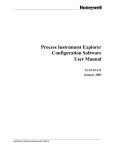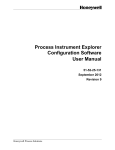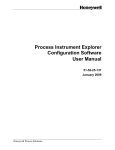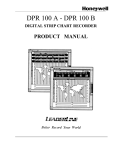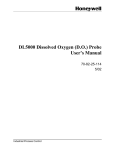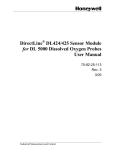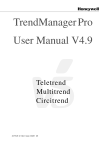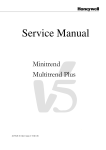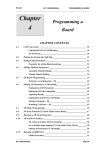Download Honeywell Welder 51-52-25-131 User's Manual
Transcript
Process Instrument Explorer Configuration Software User Manual 51-52-25-131 March 2006 Industrial Measurement and Control Notices and Trademarks Copyright 2006 by Honeywell Revision 7 March 2006 WARRANTY/REMEDY Honeywell warrants goods of its manufacture as being free of defective materials and faulty workmanship. Contact your local sales office for warranty information. If warranted goods are returned to Honeywell during the period of coverage, Honeywell will repair or replace without charge those items it finds defective. The foregoing is Buyer's sole remedy and is in lieu of all other warranties, expressed or implied, including those of merchantability and fitness for a particular purpose. Specifications may change without notice. The information we supply is believed to be accurate and reliable as of this printing. However, we assume no responsibility for its use. While we provide application assistance personally, through our literature and the Honeywell web site, it is up to the customer to determine the suitability of the product in the application. Industrial Measurement and Control Honeywell 1100 Virginia Drive Fort Washington, PA 19034 Process Instrument Explorer is a U.S. registered trademark of Honeywell Other brand or product names are trademarks of their respective owners. 03/06 Process Instrument Explorer Configuration Software User Manual ii About This Document Abstract This document provides descriptions and procedures for the installation and operation of Process Instrument Explorer software. Contacts World Wide Web The following lists Honeywell’s World Wide Web sites that will be of interest to our customers. Honeywell Organization WWW Address (URL) Corporate http://www.honeywell.com Industrial Measurement and Control http://www.honeywell.com/imc Telephone Contact us by telephone at the numbers listed below. Organization United States and Canada 03/06 Honeywell Phone Number 1-800-423-9883 Tech. Support 1-800-525-7439 Service Process Instrument Explorer Configuration Software User Manual iii Contents 1 INTRODUCTION ................................................................................................... 1 1.1 2 Overview.........................................................................................................................................1 1.1.1 Features ................................................................................................................................1 INSTALLATION..................................................................................................... 3 2.1 System Requirements......................................................................................................................3 2.2 Install/Upgrade Procedure...............................................................................................................4 2.3 Uninstall Procedure.........................................................................................................................6 3 OPERATIONS ....................................................................................................... 7 3.1 4 Overview.........................................................................................................................................7 3.1.1 Communications Setup ......................................................................................................10 3.1.2 Upload................................................................................................................................11 3.1.3 Offline Configuration.........................................................................................................12 3.1.4 Download ...........................................................................................................................13 3.1.5 Online Configuration .........................................................................................................14 3.1.6 Maintenance Data...............................................................................................................15 3.1.7 Infrared checklist................................................................................................................16 3.1.8 Ethernet Q&A ....................................................................................................................17 SERVICES........................................................................................................... 18 4.1 Overview.......................................................................................................................................18 4.1.1 Pocket PC Services Menu ..................................................................................................18 4.1.2 PC Services Menu ..............................................................................................................18 4.2 Export Configuration (PC only)....................................................................................................20 4.3 Transfer Configuration..................................................................................................................20 4.4 Manage Configuration Files .........................................................................................................21 4.5 Install Descriptive File (PC only) .................................................................................................21 4.6 Transfer Descriptive File (PC only)..............................................................................................22 4.7 Transfer Healthwatch Data (Pocket PC only, UDC3500 only) ....................................................22 4.8 Enable Descriptive Name Support ................................................................................................22 4.9 Import Database ............................................................................................................................23 4.10 Export Database ........................................................................................................................24 5 INDEX .................................................................................................................. 25 6 SALES AND SERVICE........................................................................................ 26 iv Process Instrument Explorer Configuration Software User Manual 03/06 Tables Table 3-1 Operations Icons _____________________________________________________________ 8 Table 3-2 Operations Menu_____________________________________________________________ 9 Table 4-1 Service menu_______________________________________________________________ 19 03/06 Process Instrument Explorer Configuration Software User Manual v Figures Figure 1-1 Screen capture of Process Instrument Explorer running on a Pocket PC _________________ 1 vi Process Instrument Explorer Configuration Software User Manual 03/06 Introduction 1 Introduction 1.1 Overview Process Instrument Explorer (P.I.E.) lets you configure Honeywell process instruments such as controllers and analyzers using a PC (desktop/laptop) or Pocket PC. Figure 1-1 Screen capture of Process Instrument Explorer running on a Pocket PC 1.1.1 Features • Create/edit configurations live, just connect software to controller comm port.· • Create/edit configurations offline and download later to controller comm port.· • Communication types available on process instruments: Infrared RS 485 Ethernet 03/06 • Common look and feel between PC and Pocket PC versions. • Same communications types on process instruments allow interconnectivity. • Available in English, Spanish, Italian, German and French. Process Instrument Explorer Configuration Software User Manual 1 Introduction • The infrared connection provides a non-intrusive wireless connection with the instrument and maintains NEMA4X AND IP66 integrity. • No need to get access to the back of the instrument to communicate with the instrument, no need to take your screw driver to wire the communication cable, no wiring mistake possible. You can now duplicate an instrument’s configuration, upload or download a new configuration in a matter of seconds, just by pointing your Pocket PC in the direction of the instrument. It takes just a few seconds to upload a configuration from an instrument. You can then save the configuration file onto your PC or pocket PC for review, modification or archiving. Furthermore, this software also gives you important maintenance information on the instrument: instantly get information on the current operating parameters, digital inputs and alarm status, identify internal or analog input problems. 2 Process Instrument Explorer Configuration Software User Manual 03/06 Installation 2 Installation 2.1 System Requirements Hardware PC CPU: Intel x86 processor RAM: 32MB Disk space: 4.2MB For IR Communications: Actisys ACT-IR220L+ http://www.actisys.com For RS-485 Communications: Technman PC5001 or equivalent RS-232/485 Converter http://www.technman.com For Ethernet Communications: 10 BaseT or 10/100 BaseT Port Pocket PC CPU: Intel PXA250/ PXA255 or later RAM: 32MB Pocket PC must have an Infrared Port or an RS485 converter Software PC Windows 2000 SP2, Windows XP SP1, Windows NT SP6 Pocket PC Pocket PC 2002 or later Microsoft Active Sync application must be installed for the PC to communicate with the Pocket PC through the Active Sync cable. 03/06 Process Instrument Explorer Configuration Software User Manual 3 Installation 2.2 Install/Upgrade Procedure Follow this procedure to install, reinstall, or upgrade P.I.E. ATTENTION: If upgrading, any P.I.E. databases (that is, saved instrument configurations) can be copied to the new P.I.E. application directory. Older databases are compatible with newer versions of P.I.E. Step 1 Action If upgrading PocketPC, perform section 2.3 Uninstall Procedure before continuing. Insert P.I.E. CD into your PC. Click “Install/Uninstall” from the opening menu. 2 Welcome Screen starts off the installation. 3 License agreement details the agreement on which you purchased this software. Continue only after reading and agreeing to these terms. 4 Select Platform Select the platform on which to install P.I.E.: PC, Pocket PC, or Both. 5 Select Version This screen appears only if P.I.E. is already installed. Use this screen to reinstall or upgrade your software. If no version is already installed then this screen does not appear; go to Step 6. To reinstall: The upper frame shows the version of the software that can be installed; click Install to reinstall the version specified. To upgrade: The lower frame shows the versions and their languages that are installed. Select a version/languages to be upgraded with the version in the upper frame, then select Upgrade. Attention: Any P.I.E. databases (that is, saved instrument configurations) can be copied. Older databases are compatible with newer versions of P.I.E. 6 PC installation: Enter User Name, Serial Number, and License Key Enter user name. Enter serial number and license key from the CD cover. Note: numbers are case-sensitive. Pocket PC installation: Microsoft Active Sync application must be installed on the PC and Pocket PC. Connect the Pocket PC to the PC with an Active Sync Cable. Power up Pocket PC. On PC select the Active Sync “Guest Partnership” type connection. Enter User Name, Serial Number, and License Key Enter user name. Enter serial number and license key from the CD cover. Note: characters are case-sensitive. 4 Process Instrument Explorer Configuration Software User Manual 03/06 Installation Step 7 Action Select Language(s) Select one or more languages to install. If installing to both the PC and the Pocket PC then the software will be first installed in the Pocket PC and then in the PC. 8 Choose Destination Select a path in which to install the software. Use the default path shown or browse to a different path. This screen does not appear if reinstalling over existing version. Note: Pocket PC devices do not have drives, so the destination folder should not contain drive information. Pocket PC destination folder must start with a “\”. 9 Select Databases to Copy This screen appears only if you previously uninstalled a version and retained the database. (A P.I.E. database contains saved instrument configurations.) If no databases were retained this screen does not appear, go to Step 10. You are shown a list of versions that are currently installed, as well as previously retained databases that have been found. You are asked to select the database version you want to copy into the newly installed/upgraded version of P.I.E. 10 Finalize installation PC: Shortcut(s) can be installed in the Start Menu of the PC. Shortcuts are named “PIE(language)(version)”. For example, “PIEEng1_00” is PIE English 1.00. Pocket PC: A popup announces that files are being transferred to the Pocket PC. A second popup announces that setup is accessing the mobile device. The Files will be copied to the directory selected in step 8. When the installation finishes, a message box reminds you to check your Pocket PC screen to see if additional steps are necessary to complete the installation. If all is ok the Pocket PC tells you the installation is complete. If your PocketPC has Windows Mobile 5.0 operating system, a popup will indicate that the software is from an unknown source. Click yes to proceed with the installation. Shortcut(s) will be installed in the Start Menu or Program Group of the Pocket PC. Shortcuts are named “PIE(language)(version)”. For example, “PIEEng1_00” is PIE English 1.00. 11 03/06 Installation/upgrade is finished. Process Instrument Explorer Configuration Software User Manual 5 Installation 2.3 Uninstall Procedure Follow this procedure to uninstall P.I.E. from your PC or Pocket PC. ATTENTION: You must uninstall older versions from your PocketPC before doing an upgrade. Step Action 1 Insert P.I.E. CD into your PC. Click “Install/Uninstall” from the opening menu. 2 Welcome Screen starts off the procedure. 3 License agreement details the agreement on which you purchased this software. Continue only after reading and agreeing to these terms. 4 Select Platform Select the platform from which to uninstall P.I.E.: PC, Pocket PC, or Both. 5 Select Version The upper frame shows the version of the software that can be installed or upgraded to; leave as is and go to lower frame. The lower frame shows the versions and their languages that are installed. Select a version/languages to uninstall, then select Uninstall. Retain Database? If any instrument configurations (that is, a P.I.E. database) exist on your PC or Pocket PC then a popup appears asking if you want to retain the database. When given the option to retain database: Select Yes to save the database for future use if: you will install P.I.E. later, or you are upgrading your PocketPC with a newer version, or you want to archive the database. The database location is then shown. Or Select “No” to delete the database. 6 6 Uninstallation is finished. Process Instrument Explorer Configuration Software User Manual 03/06 Operations 3 Operations 3.1 Overview The PC and Pocket PC Operations are virtually identical. Any differences will be indicated. Operations choices are: Communications Setup—Before uploading or downloading instrument configurations you must set up communications. Upload Database—Uploads instrument configuration to PC/Pocket PC. Offline Configuration—Edits an instrument configuration for later downloading. Download—Downloads an instrument configuration to an instrument. Online Configuration—Edits and downloads one instrument setting at a time. Maintenance Data—Displays key operating parameters and status parameters of the instrument without switching between the instrument screens. Some of the information presented here is not visible through the instrument display panel. Used primarily for diagnostics. The Operations features are accessed using icons (Table 3-1) or the Menu (Table 3-2). 03/06 Process Instrument Explorer Configuration Software User Manual 7 Operations Table 3-1 Operations Icons PC 8 Pocket PC Process Instrument Explorer Configuration Software User Manual 03/06 Operations Table 3-2 Operations Menu 03/06 PC Pocket PC (click Operations) (tap Menu/Operations) Process Instrument Explorer Configuration Software User Manual 9 Operations 3.1.1 Communications Setup Before transferring data between P.I.E. and instrument you must set up your PC or Pocket PC communication parameters using this procedure. Step Action 1 Select “Communication Setup” or “PC Comm Setup” icon or menu item. 2 Select “Communication type” to be used with the process instrument: Infrared, RS485, or Ethernet. The status bar at the bottom of the screen indicates your choice. Note 1: Ethernet feature is not supported in Pocket PC. Note 2: IPAQ Pocket PCs do not support serial communication. 3 “Select Type to set up” Infrared: Device address: Enter address of the process instrument. Default 3. Serial Port (PC only): Your PC requires an Infrared cable to communicate with the instrument. This cable must be plugged into the PC’s Serial Port. Enter that port number here. IR Port (Pocket PC only): Your Pocket PC will attempt to automatically determine the IR port address during the installation process. If successful, the IR port will be automatically set and cannot be changed. If unsuccessful, you must specify the IR port address using the drop down menu. Contact Honeywell Technical Support for assistance. RS485 Device address: Enter address of the process instrument. Default 3. Serial Port (PC only): Your PC requires a RS232/RS485 converter to communicate with the instrument. This cable must be plugged into the PC’s Serial Port. Enter that port number here. Serial Port (Pocket PC only): Your Pocket PC will attempt to automatically determine the serial port address during the installation process. If successful, the serial IR port will be automatically set and cannot be changed. If unsuccessful, you must specify the IR port address using the drop down menu. Contact Honeywell Technical Support for assistance. Your Pocket PC requires a RS232/RS485 converter to communicate with the instrument. This cable must be plugged into the Pocket PC’s Serial Port. See your instrument’s manual for wiring details. Ethernet IP address: Enter instrument’s IP address. Default 10.0.0.2. Timeout (1 – 20 sec): Enter number of seconds of non-response before timeout. As network traffic increases this will need to be increased. Retries (2 to 60): Enter number of attempts to connect. As network traffic increases this will need to be increased. See your instrument’s manual for wiring details. 4 10 Pocket PC only: For Infrared communication, verify that the beam settings checkbox in the Pocket PC system software is UNCHECKED. This checkbox is located at: Start\Settings\Connections\Beam. Infrared communications will not work with if this box is checked. Process Instrument Explorer Configuration Software User Manual 03/06 Operations 3.1.2 Upload Upload copies your instrument’s configuration into P.I.E. where it can be saved, edited, and downloaded back to the instrument or other instruments. Attention Infrared users: Before transferring data between your instrument and PC/Pocket PC, see Infrared checklist on page 16. Step Action 1 Select Upload icon or menu item. Upload Configuration box appears. 2 Click Start. If using Infrared, first press any instrument button to activate infrared, then aim the beam at the instrument, then click Start. 3 Status of upload (% complete) is shown. Also, at bottom of display a green Transmission Status icon flashes during transmission. To terminate upload, select Abort. If upload is successful you are given option to save the configuration or cancel. If infrared upload failed see Infrared checklist on page 16. 03/06 Process Instrument Explorer Configuration Software User Manual 11 Operations 3.1.3 Offline Configuration Offline Configuration lets you edit an instrument’s configuration file for later downloading to an instrument. . This operation is mostly used during initial configuration where the configuration from one instrument is copied, duplicated, or modified and then downloaded to other instruments. Step Action 1 Select “Offline Configuration” icon or menu item. 2 Available Device Types (process instruments) are shown. Select Device Type whose configuration you want to edit, for example, UDC2500. 3 Previously saved configurations are shown in the File List. Double-click/double-tap a configuration to edit. The prompts are organized exactly as on the instrument itself. For details on functions and their settings, refer to that instrument’s manual. If an analog configuration is highlighted with red text or a digital configuration is shown blank, it means that the stored value is now out of range, either because of previous changes to the instrument’s configuraton or because of incompatibilities with the configuration set. Change the configuration to an in-range setting to correct the error. 4 Ethernet users have an additional Group: Ethernet & Email. You can set up an email to be sent when a rising edge (off-to-on) alarm is detected. Alarm status is checked every 30 seconds, so only one rising edge will be detected per 30 seconds. Attention: -In controllers, updates to Ethernet parameters may take up to 60 seconds to take effect. After you change the instrument’s IP address, to make it recognized you must execute the “arp-d” command at a DOS prompt. For more info see Ethernet Q&A on page 17. Ethernet Setup IP Address: IP address of the instrument. Subnet Mask: Subnet mask of the instrument Default Gateway: Default gateway of the instrument Email Setup—use the following parameters to configure an email notification during an alarm. Select Email: Select which email to configure. To Email: Enter email address of person to be emailed SMTP Address (for outgoing): Enter exchange server address From Email: This is the e-mail ID that appears in the “From” field when the recipient receives an e-mail from the instrument. It can be any e-mail ID of the user’s choice, basically to help identify the device. (e.g: [email protected]) Select Alarm: Select an alarm whose activation will send the email. To select none, click on the highlighted alarm. Email Subject: Enter email subject text. 5 12 To view or edit a configuration’s Properties, in the File List right-click on the File name (PC) or select “Properties” (Pocket PC). File name Device type Uploaded date and time Last modified date and time Author name - Description Process Instrument Explorer Configuration Software User Manual 03/06 Operations 3.1.4 Download Download sends your P.I.E. instrument configuration to the instrument. Attention Infrared users: Before transferring data between your instrument and PC/Pocket PC, see Infrared checklist on page 16. Step Action 1 Select Download icon or menu item. 2 Available Device Types (process instruments) are shown. Select Device Type whose configuration you want to download, for example, UDC2500. 3 Previously saved configurations are shown in the File List. Double-click/double-tap a configuration to be downloaded. 4 Click Start. If using Infrared, first press any instrument button to activate infrared, then aim the beam at the instrument, then click Start. 5 If the configuration being downloaded includes a change to the instrument’s address (that is, Infrared/RS4585 device address and/or Ethernet IP address) then a popup asks you if you want to overwrite the address(s). This helps protect against mismatched addresses between instrument and the configuration in P.I.E.. Attention: -In controllers, updates to Ethernet parameters may take up to 60 seconds to take effect. After you change the instrument’s IP address, to make it recognized you must execute the “arp-d” command at a DOS prompt. 6 Status of download (% complete) is shown. Also, at bottom of display a green Transmission Status icon flashes if transmission is normal. To terminate download, select Abort. If download is successful you are given option to Close the dialog box. If infrared download failed, see Infrared checklist on page 16. 03/06 Process Instrument Explorer Configuration Software User Manual 13 Operations 3.1.5 Online Configuration Online Configuration lets you upload an instrument configuration and write one change at a time back to the instrument. This is useful for tuning your instrument and is faster than downloading the entire configuration. For multiple changes consider doing offline configuration. Step Action 1 Select “Online Configuration” icon or menu item. 2 Click/tap Start to begin upload. If using Infrared, first press any instrument button to activate infrared, then aim the beam at the instrument, then click Start. 3 Status of upload (% complete) is shown. Also, at bottom of display a green Transmission Status icon flashes during transmission. To terminate upload, select Abort. If upload is successful you are given option to save the configuration or cancel. If infrared upload failed see Infrared checklist on page 16. 4 If upload was successful the configuration will appear. 5 Select a Group and edit a Function. For details on functions and their settings, refer to that instrument’s manual. If an analog configuration is highlighted with red text or a digital configuration is shown blank, it means that the value read up from the instrument is now out of range, either because of previous changes to the instrument’s configuraton or because of incompatibilities with a downloaded configuration set. Change the configuration to an inrange setting to correct the error. 6 Ethernet users have an additional Group: Ethernet & Email. You can set up an email to be sent when a rising edge (off-to-on) alarm is detected. Alarm status is checked every 30 seconds, so only one rising edge will be detected per 30 seconds. Attention: -In controllers, updates to Ethernet parameters may take up to 60 seconds to take effect. -After you change the instrument’s IP address, to make it recognized you must execute the “arp-d” command at a DOS prompt. For more info see Ethernet Q&A on page 17. Ethernet Setup IP Address: IP address of the instrument. Subnet Mask: Subnet mask of the instrument. Default Gateway: Default gateway of the instrument. Email Setup—use the following parameters to configure an email notification during an alarm. Select Email: Select which email to configure. To Email: Enter email address of person to be emailed. SMTP Address (for outgoing): Enter exchange server address. From Email: This is the e-mail ID that appears in the “From” field when the recipient receives an e-mail from the instrument. It can be any e-mail ID of the user’s choice, basically to help identify the device. (e.g: [email protected]) Select Alarms: Select an alarm whose activation will send the email. Email Subject: Enter email subject text. 14 7 Select Write to download the edit to the instrument. Display indicates if write was successful or failed. If write failed see Infrared checklist on page 16. If successful you can edit/write another function. ATTENTION! No warning is given if you overwrite address info (IP, Subnet Mask, Gateway) so be aware of what you are doing! 8 Close window. You are given the option to save the changed configuration for later use in P.I.E. Process Instrument Explorer Configuration Software User Manual 03/06 Operations 3.1.6 Maintenance Data Maintenance Data displays key operating parameters and status parameters of the instrument without switching between the instrument screens. Some of the information presented here is not visible through the instrument display panel. Used primarily for diagnostics. Step 03/06 Action 1 Select “Maintenance Data” icon or menu item to. If using Infrared, first press any instrument button to activate infrared, then aim the beam at the instrument, then select Maintenance Data. 2 A window appears with maintenance data such as loops, alarms, events. If using RS485 or Ethernet the data is refreshed automatically. If using infrared you must refresh manually. Process Instrument Explorer Configuration Software User Manual 15 Operations 3.1.7 Infrared checklist Check the following before using infrared communications. Infrared transmitter (Cable or Pocket PC) - The Infrared transmitter is pointed directly at the process instrument’s Infrared port. - The Infrared transmitter is located no more than 0.3 meters (1 foot) away from the process instrument. Process instrument: - The process instrument is configured with an Infrared port (Infrared on the UDC2500 is optional; Non Infrared units can be configured using the test jack port, RS485 or Ethernet). - The process instrument’s device address must match the device address in the P.I.E. Communications Setup. - The process instrument’s Infrared port must be enabled through its communications menu. - Any button must be pressed on the process instrument to enable the Infrared port for 4 minutes. - There are no obstructions between the Infrared transmitter and the process instrument. P.I.E.: - There is only one process instrument with the device address selected in the P.I.E. Communication Setup. - The communications mode in the P.I.E. application must be set to Infrared. (Verify by looking at mode displayed in lower left corner of P.I.E. display.) Pocket PC: 16 - IMPORTANT: The beam checkbox in the Pocket PC must be unchecked. See Start\Settings\Connection\Beam. Infrared communications will not work if box is checked. - A valid IR port address has been assigned through the Infrared Communications Setup screen. - Dell X5 Pocket PCs require a patch from the Dell website. - Dell X3 Pocket PCs may require a patch from the Dell website. Process Instrument Explorer Configuration Software User Manual 03/06 Operations 3.1.8 Ethernet Q&A Q: How can I find the address of my Honeywell instrument? A: The Ethernet address information that has been set in the instrument can be retrieved by using P.I.E. to upload a product configuration upload using IR communication. After the upload you can view the Ethernet group and see the Ethernet information. An alternate way is to use P.I.E. and initiate an online configuration through IR communication. This function does an initial upload of the current configuration from the instrument and displays the groups. The Ethernet information can be viewed from the Ethernet group. The above cannot be done through RS485 communication because when the Ethernet board is plugged in, the RS485 option is not available. The default Ethernet information for a UDC as shipped from the factory is IP 10.0.0.2, Mask 255.255.255.0, Gateway 0.0.0.0. Q: How do I know what IP Address to use? A: The default IP address provided from the factory is 10.0.0.2 on the UDC. Since IP addresses must be unique, you will need reset the IP address for multiple instruments or if the instrument is going to be placed on a LAN. Multiple instruments on a local net could be set at 10.0.0.2, 10.0.0.3, 10.0.0.4, etc. If you want to put the instrument on a LAN, you need to obtain available IP addresses from your IT group. Q: How do I know what Mask to use? A: The mask on the UDC is normally set to 255.255.255.0 since the first (3) numbers in the IP address are typically the same for instruments on the same subnet. Q: How do I know what Gateway to use? A: The gateway information is the IP address of the router which would route the TCP/IP traffic to the appropriate destination IP address. Every network has a gateway routing device that holds the routing table for that network which specifies how to route TCP/IP packets between network devices. In the P.I.E. and UDC case, if the PC on which the P.I.E. is running and UDC are connected to a LAN, then the gateway should have the IP Address of the router that manages the LAN subnetwork. In the case of the PC on which the P.I.E. is running being connected directly to the UDC with a crossed Ethernet cable, then the gateway IP address can be set to "0.0.0.0". The normal procedure is to copy the first three bytes of the IP address from the PC and set the last byte to 1. For example, if the IP address of the PC is set to 10.2.3.4 then set the gateway IP address to be 10.2.3.1. Q: How do I know what SMTP address to use? A: The SMTP address is used for outgoing emails. This address is specific to your LAN configuration and can be obtained from your IT group. Q: Why can’t I communicate with my controller after I changed the controller’s IP address? A: The arp table in your desktop PC needs to be reset by typing “arp-d” in the DOS command window. Also, changes to Ethernet parameters may take up to 60 seconds to take effect. 03/06 Process Instrument Explorer Configuration Software User Manual 17 Services 4 Services 4.1 Overview Services lets you manage your files through the following menus. 4.1.1 Pocket PC Services Menu Transfer Configuration - Lets you copy device configurations saved in the Pocket PC to the PC. Transferred files may then be opened, edited, saved and downloaded from the PC. Manage Configuration Files - Lets you copy, delete, rename and view the properties of saved configuration files. Transfer Healthwatch Data – For future release. This feature transfers Healthwatch data to the desktop PC. Available only for the UDC3500 controller. Enable Descriptive Name Support - When enabled, Descriptive Name uses 16 characters to describe your configuration groups, functions and parameters in more detail than the instrument’s 8-character display. The descriptive names come from the descriptive file). Import Database – Lets you add all or part of another database to your current configuration database. You may import configurations created on other PCs and Pocket PCs. Export Database – Lets you save all or part of the current database so that it may later be imported. 4.1.2 PC Services Menu Export Configuration - Lets you write a configuration file to a .csv formatted file which can be read into spreadsheet software. Transfer Configuration - Lets you copy device configurations saved in the PC to the Pocket PC application. Transferred files may then be opened, edited, saved and downloaded from the Pocket PC. Manage Configuration Files - Lets you copy, delete, rename and view the properties of saved configuration files. Install Descriptive File - Lets you attach a new 16-character descriptive file to the desktop/laptop tool. Descriptive files are specific to instrument version and type. See Enable Descriptive Name Support. Transfer Descriptive File - Lets you transfer a new 16-character descriptive file from the desktop/laptop to the Pocket PC. (Descriptive files are provided by Honeywell.) See Enable Descriptive Name Support. 18 Process Instrument Explorer Configuration Software User Manual 03/06 Services Enable Descriptive Name Support – When enabled, Descriptive Name uses 16 characters to describe your configuration groups, functions and parameters in more detail than the instrument’s 8-character display. The descriptive names come from the descriptive file. Import Database – Lets you add all or part of another database to your current configuration database. You may import configurations created on other PCs and Pocket PCs. Export Database – Lets you save all or part of the current database so that it may later be imported. Table 4-1 Service menu 03/06 PC Services menu Pocket PC Services menu (click “Services”) (tap “Menu/Services”) Process Instrument Explorer Configuration Software User Manual 19 Services 4.2 Export Configuration (PC only) Export Configuration lets you write a configuration file to a .CSV formatted file which can be read into spreadsheet software. Step Action 1 Select Export Configuration from the Services menu. 2 Select device (instrument) type. 3 Select configuration to be exported. 4 Enter destination and name of exported file. 5 Click Export. A popup confirms whether the export was successful. 4.3 Transfer Configuration Transfer Configuration lets you copy configurations between the Pocket PC and the PC. Transferred files may then be opened, edited, saved and downloaded. Before proceeding: • Microsoft Active Sync must be installed on the Pocket PC. • Connect the Pocket PC to the PC with an Active Sync Cable. • Power up Pocket PC. • On PC, if Active Sync dialog box appears select “Guest Partnership” type connection. Step 20 Action 1 Select Transfer Configuration from the Services menu. 2 Select device (instrument) type. 3 Select configuration(s) to be transferred. Click Next. 4 Click Transfer. A popup confirms whether the transfer was successful. Process Instrument Explorer Configuration Software User Manual 03/06 Services 4.4 Manage Configuration Files Lets you copy, delete, rename and view the properties of saved configuration files. Step Action 1 Select Manage Configuration Files/Manage Files from the Services menu. 2 Select device (instrument) type. 3 Select configuration. Click on headings to sort. 4 Pocket PC users must first select File to access the following items. Copy: Select to make a copy of the file. Enter new file name. Delete: Select to delete the file. Rename: Select to rename the file. Properties: Select to view or edit the following: - File name - Device type - Uploaded date and time - Last modified date and time - Author name - Description 4.5 Install Descriptive File (PC only) Lets you attach a new 16-character descriptive file to the desktop/laptop tool. (Descriptive files are provided by Honeywell.) See Enable Descriptive Name Support. Step 03/06 Action 1 Select Install Descriptive File from the Services menu. 2 Browse to the new file. These files will be sent by factory or through the internet or email. Select the file from the location it was saved after downloading it from the internet or email; there is no specific extension for descriptive files. P.I.E. will verify whether the selected file is valid. Process Instrument Explorer Configuration Software User Manual 21 Services 4.6 Transfer Descriptive File (PC only) Lets you transfer a new 16-character descriptive file from the desktop/laptop to the Pocket PC. (Descriptive files are provided by Honeywell.) See Enable Descriptive Name Support. Step Action 1 Select Transfer Descriptive File from the Services menu. 2 Browse to the new file. These files will be sent by factory or through the internet or email. Select the file from the location it was saved after downloading it from the internet or email; there is no specific extension for descriptive files. P.I.E. will verify whether the selected file is valid. 4.7 Transfer Healthwatch Data (Pocket PC only, UDC3500 only) For future release. Lets you transfer an instrument’s previously saved Healthwatch data from the Pocket PC to the desktop/laptop. This data is saved with .CSV (Comma Separated Values) extension. Since the Pocket PC does not have a .CSV file viewer and it cannot be opened in Pocket Excel, the saved .CSV file can be transferred to the Desktop PC and viewed through any of the standard viewers that support .CSV format. Step Action 1 Select Transfer Healthwatch Data from the Services menu. 2 Browse to the Healthwatch file you want to transfer. Default file is "UDCXXXXvNN_HWm.csv" where: XXXX is device model (2500) NN is firmware version (01,02,...) m is m'th instance of the healthwatch saved. You will have the choice to modify this name. Example: UDC2500v01_HW2.csv would be the default name for the second instance of the Healthwatch file when saved for a 2500 unit with firmware version '01'. 4.8 Enable Descriptive Name Support When enabled, Descriptive Name uses 16 characters to describe your configuration groups, functions and parameters in more detail than the instrument’s 8-character display. The descriptive names come from the descriptive file. Step 22 Action 1 To enable, check Enable Descriptive Name Support from the Services menu. Groups, functions and parameters will be displayed in detail. 2 To disable, uncheck. Groups, functions and parameters will be displayed in abbreviated form. Process Instrument Explorer Configuration Software User Manual 03/06 Services 4.9 Import Database Lets you add all or part of another database to your current configuration database. You may import configurations created on other PCs and Pocket PCs. Step Action 1 Enter the name of the database you wish to import using the Browse function. (The file format for Process Instrument Explorer databases is *.Nge) 2 If you wish to import the entire database, select the “Import Entire Database” checkbox, then skip to Step 5. 3 If you wish to import part of the database, select the Device Type representing the configurations you wish to import (for example, UDC2500). 4 To add the files you wish to import to the Selected Configurations to Import list, highlight the desired configurations in the left column and press the “Add >” button. You may also use the “Add All >>” button to transfer all of the configuration(s) for the current device type into the Selected Configuration List. To remove configurations from the Selected Configurations to Import list, highlighti a configuration in the right column and press the “< Remove” button. You may also use the << Remove All” button to remove all of the configurations from the Selected Configurations to Import list. 5 03/06 Press the Import button to add the configurations appearing in the Selected Configurations to Import list to your current database. (Note that if the “Import Entire Database” checkbox is selected, no files will be shown in the Selected Configurations to Import list) Process Instrument Explorer Configuration Software User Manual 23 Services 4.10 Export Database Lets you save all or part of the current database so that it may later be imported. Step Action 1 Select the Device Type for configuration(s) you wish to Export (for example, UDC2500). 2 If you wish to export the entire database, select the “Export Entire Database” checkbox, then skip to Step 5. 3 If you wish to export part of the database, select the Device Type representing the configurations you wish to export. 4 To add the files you wish to export to the Selected Configurations to Export list, highlight the configuration in the left column and press the “Add >” button. You may also use the “Add All >>” button to transfer all of the configuration(s) for the current device type into the Selected Configurations to Export list. To remove configurations from the Selected Configurations to Export list, highlight a configuration in the right column and press the “< Remove” button. You may also use the << Remove All” button to remove all of the configurations from the Selected Configurations to Export list. 24 5 Enter the name of the database file you wish to create by typing the path\filename or using the Browse function. Once a path is selected a default filename of ExportNgcDB.nge appears. You may change the filename by overwriting the default. 6 Press the Export button to create a new database file containing the configurations listed on the Selected Configurations to Export list. Process Instrument Explorer Configuration Software User Manual 03/06 Index 5 Index alarm email, 12, 14 Communications setup, 10 Device Types, 12, 13 Download, 13 email, 12, 14 Enable Descriptive Name Support, 22 Ethernet Q&A, 17 Ethernet & Email, 12, 14 Export Configuration, 20 Export Database, 24 Import Database, 23 Infrared checklist, 16 Install Descriptive File, 21 Install/Upgrade, 4 Manage Configuration Files, 21 Offline Configuration, 12 Online Configuration, 14, 15 Operations, 7 Communications setup, 10 Download, 13 icons, 8, 19 03/06 menu, 9 Offline Configuration, 12 Online Configuration, 14, 15 Upload, 11 PC Comm Setup, 10 Properties, 12 Services, 18 Enable Descriptive Name Support, 22 Export Configuration, 20 Export Database, 24 Import Database, 23 Install Descriptive File, 21 Manage Configuration Files, 21 Transfer Configuration, 20 Transfer Descriptive File, 22 Transfer Healthwatch Data, 22 System Requirements, 3 Transfer Configuration, 20 Transfer Descriptive File, 22 Transfer Healthwatch Data, 22 Uninstall, 4, 6 Upload, 11 Process Instrument Explorer Configuration Software User Manual 25 Sales and Service 6 Sales and Service For application assistance, current specifications, pricing, or name of the nearest Authorized Distributor, contact one of the offices below. ARGENTINA Honeywell S.A.I.C. Belgrano 1156 Buenos Aires Argentina Tel. : 54 1 383 9290 ASIA PACIFIC Honeywell Asia Pacific Inc. Room 3213-3225 Sun Kung Kai Centre N° 30 Harbour Road Wanchai Hong Kong Tel. : 852 829 82 98 AUSTRALIA Honeywell Limited 5 Thomas Holt Drive North Ryde Sydney Nsw Australia 2113 Tel. : 61 2 353 7000 AUSTRIA Honeywell Austria G.M.B.H. Handelskai 388 A1020 Vienna Austria Tel. : 43 1 727 800 BELGIUM Honeywell S.A. 3 Avenue De Bourget B-1140 Brussels Belgium Tel. : 32 2 728 27 11 BRAZIL HONEYWELL DO Brazil And Cia Rua Jose Alves Da Chunha Lima 172 Butanta 05360.050 Sao Paulo Sp Brazil Tel. : 55 11 819 3755 BULGARIA HONEYWELL EOOD 14, Iskarsko Chausse POB 79 BG- 1592 Sofia BULGARIA Tel : 359-791512/ 26 794027/ 792198 CANADA Honeywell Limited The Honeywell Centre 300 Yorkland Blvd. Toronto, Ontario M2j 1s1 Canada Tel.: 800 461 0013 Fax:: 416 502 5001 Tel. : 36 1 451 43 00 Tel. : 351 1 424 50 00 Tel. : 421 7 52 47 400/425 ICELAND HONEYWELL Hataekni .hf Armuli 26 PO Box 8336 128 reykjavik Iceland Tel : 354 588 5000 REPUBLIC OF IRELAND HONEYWELL Unit 1 Robinhood Business Park Robinhood Road DUBLIN 22 Republic of Ireland Tel. : 353 1 4565944 SPAIN HONEYWELL S.A Factory Josefa Valcarcel, 24 28027 MADRID SPAIN Tel. : 34 91 31 3 61 00 CZECH REPUBLIC HONEYWELL, Spol.S.R.O. Budejovicka 1 140 21 Prague 4 Czech Republic Tel. : 42 2 6112 3434 ITALY HONEYWELL S.p.A. Via P. Gobetti, 2/b 20063 Cernusco Sul Naviglio ITALY Tel. : 39 02 92146 1 DENMARK HONEYWELL A/S Automatikvej 1 DK 2860 Soeborg DENMARK Tel. : 45 39 55 56 58 FINLAND HONEYWELL OY Ruukintie 8 FIN-02320 ESPOO 32 FINLAND Tel. : 358 0 3480101 FRANCE HONEYWELL S.A. Bâtiment « le Mercury » Parc Technologique de St Aubin Route de l’Orme (CD 128) 91190 SAINT-AUBIN FRANCE Tel. from France: 01 60 19 80 00 From other countries: 33 1 60 19 80 00 GERMANY HONEYWELL AG Kaiserleistrasse 39 D-63067 OFFENBACH GERMANY Tel. : 49 69 80 64444 HUNGARY HONEYWELL Kft Gogol u 13 H-1133 BUDAPEST HUNGARY MEXICO HONEYWELL S.A. DE CV AV. CONSTITUYENTES 900 COL. LOMAS ALTAS 11950 MEXICO CITY MEXICO Tel : 52 5 259 1966 THE NETHERLANDS HONEYWELL BV Laaderhoogtweg 18 1101 EA AMSTERDAM ZO THE NETHERLANDS Tel : 31 20 56 56 911 NORWAY HONEYWELL A/S Askerveien 61 PO Box 263 N-1371 ASKER NORWAY Tel. : 47 66 76 20 00 POLAND HONEYWELL Sp.z.o.o UI Domaniewksa 41 02-672 WARSAW POLAND Tel. : 48 22 606 09 00 PORTUGAL HONEYWELL PORTUGAL LDA Edificio Suecia II Av. do Forte nr 3 - Piso 3 2795 CARNAXIDE PORTUGAL REPUBLIC OF SINGAPORE HONEYWELL PTE LTD BLOCK 750E CHAI CHEE ROAD 06-01 CHAI CHEE IND.PARK 1646 SINGAPORE REP. OF SINGAPORE Tel. : 65 2490 100 REPUBLIC OF SOUTH AFRICA HONEYWELL Southern Africa PO BOX 138 Milnerton 7435 REPUBLIC OF SOUTH AFRICA Tel. : 27 11 805 12 01 ROMANIA HONEYWELL Office Bucharest 147 Aurel Vlaicu Str., Sc.Z., Apt 61/62 R-72921 Bucharest ROMANIA Tel : 40-1 211 00 76/ 211 79 RUSSIA HONEYWELL INC 4 th Floor Administrative Builiding of AO "Luzhniki" Management 24 Luzhniki 119048 Moscow RUSSIA Tel : 7 095 796 98 00/01 SLOVAKIA HONEYWELL Ltd Mlynske nivy 73 PO Box 75 820 07 BRATISLAVA 27 SLOVAKIA SWEDEN HONEYWELL A.B. S-127 86 Skarholmen STOCKHOLM SWEDEN Tel. : 46 8 775 55 00 SWITZERLAND HONEYWELL A.G. Hertistrasse 2 8304 WALLISELLEN SWITZERLAND Tel. : 41 1 831 02 71 TURKEY HONEYWELL A.S. Caryiryolu Sok No. 7 Ucgen Plaza, Kat 5-6-7 Icerenkoy 81120 Instanbul Turkey Tel (90-216) 575 66 00 UNITED KINGDOM HONEYWELL Honeywell House Arlington Business Park Bracknell, Berkshire RG12 1EB Tel: +44 (0) 1344 656000 U.S.A. HONEYWELL INC. INDUSTRIAL PROCESS CONTROLS 1100 VIRGINIA DRIVE PA 19034-3260 FT. WASHINGTON U.S.A. Tel. : 1-800-343-0228 VENEZUELA HONEYWELL CA APARTADO 61314 1060 CARACAS VENEZUELA Tel. : 58 2 239 0211 Process Instrument Explorer Configuration Software User Manual 03/06 03/06 Process Instrument Explorer Configuration Software User Manual 27 Industrial Measurement and Control Honeywell 1100 Virginia Drive Fort Washington, PA 19034 51-52-25-131 Rev. 03/06 Printed in USA www.honeywell.com/imc


































